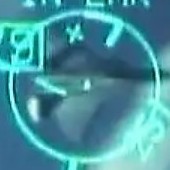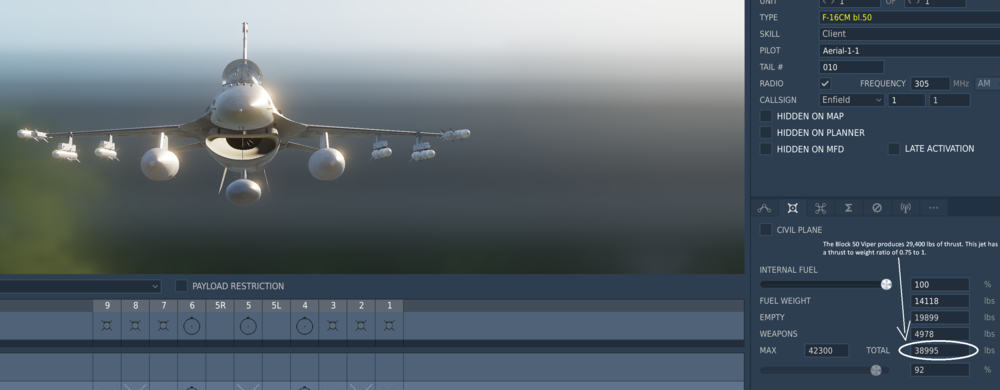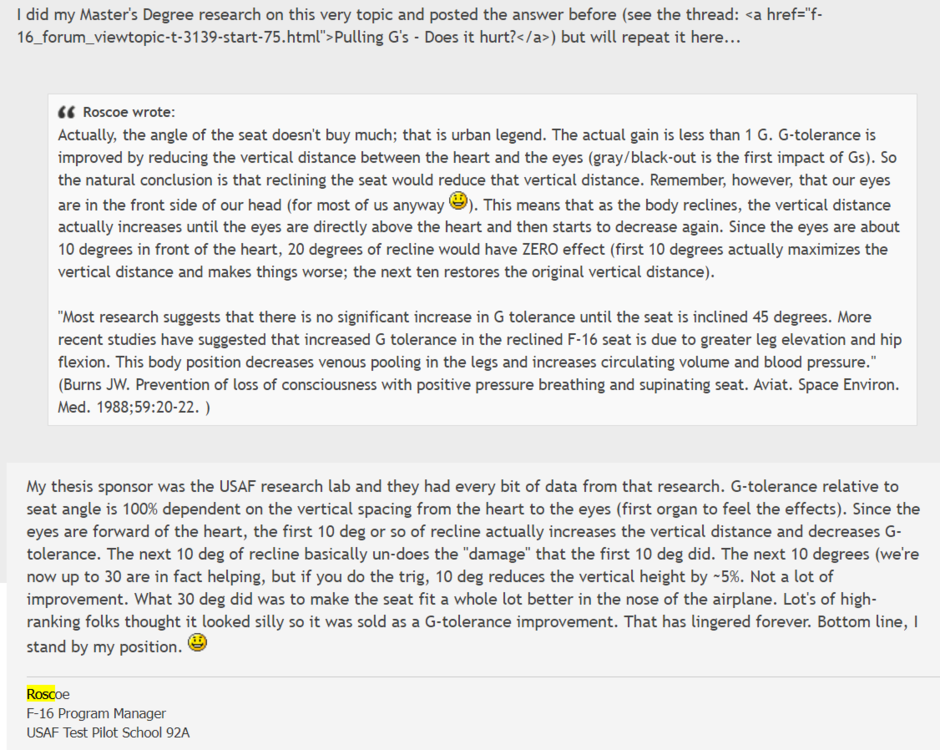-
Posts
1976 -
Joined
-
Last visited
-
Days Won
1
Content Type
Profiles
Forums
Events
Everything posted by wilbur81
-
This is probably ED getting a more accurate pylon/stores drag model on the Viper. The Hornet in this little test mission I created before yesterday's update has a better than 1:1 thrust to weight over the Viper's only 0.75:1 (the weights of both jets are shown in the screenshots attached). The Viper achieved Mach 1 in the exact same amount of time (32 seconds from mission start with full A/B and altitude hold, at the same altitudes and starting airspeeds) as the Hornet that had thrust to spare. Additionally, the Viper achieved a maximum speed of Mach 1.26 while the "slicker" Hornet only achieved Mach 1.2. Again, the Lot 20 Hornet's two F404-402s produce a total of 35,400 lbs of thrust while the Block 50 Viper's F110-GE-129 only produces 29,499 lbs of thrust. It sounds like they have gotten the drag values more realistic for the Viper.... but I've yet to test my attached mission on yesterday's new update. ViperHornet TtoW (1).miz
-

Can we expect any new features in the future?
wilbur81 replied to Digitalvole's topic in DCS: F/A-18C
An air lunch decoy could help a lot of folks who struggle to say 'no' to those extra calories at mid-day-meals. But seriously, as someone who RELISHES landing the Hornet manually on the carrier in all weather, day/night... I'll take a complete, 99% bug-free, fully MSI integrated and working TWS, air-to-air radar before even thinking about anything you've listed above. -
I've been compiling a list of Radar bugs (air to air stuff only) that are already marked "reported" or "investigating" that I've been considering asking ED about the possibility of either: a) Creating a separate "Radar" subsection in the bugs area of the forum. or b) Allowing for a sticky thread of marked -"reported" links to each and every Hornet Radar bug. This would merely be to keep important radar bugs from getting more and more deeply buried. (i.e. the TWS/MSI "jump around" bug, enemy missile lock bug, ghost TWS track bug, etc. ending up on page 6 or 7 of the bug tracker forum section.) The purpose of the thread WOULD NOT be for bitching and whining about the current state of things, but just to prioritize a bit and allow new reports of old or new radar bugs to get filtered to their appropriate place and, ideally, get addressed more promptly. (I'm sure ED has their own in-house bug tracker.) The conviction here is that the radar is the heart and soul of this awesome Navy fighter and it should (in my mind) be prioritized over other sensors that are a bit less complex. FLIR is awesome, but it doesn't have all the same complexity of the Radar and it's implementation. I would LOVE to see a real focus on our APG-73 and cleaning it all up. Again, on an entry level... it is an AMAZING achievement that ED has going with our current radar. But as you drill down a bit into multi-bogey, maneuvering engagements, flowing in and out of various modes, settings, and weapons...you notice all kinds of craziness that is hair-pulling-ly frustrating. To ED's credit, these are mostly acknowledged and, again, marked as "reported." Just wanting to see those marked as "fixed" in the nearer future if possible.
-
Looking forward to the surprise (at least to me ) expansion! Keep up the awesome work on this epic map!
-
Read the F-16 Program Manager's words from four posts back.
-
That is perfectly valid.
-

F-16C vs F/A-18C for BVR & AA in general
wilbur81 replied to El buscador de la verdad's topic in Chit-Chat
Couldn't have said it much better. -

Real pilot: sustains 9.5G for 11 second while making conversation
wilbur81 replied to karasawa's topic in DCS Core Wish List
That is true. And yes. I've also heard of plenty of G-loc deaths... in the Eagle and Viper communities. Eagle, Hornet, Viper, Raptor, Talon, and all others have to deal with spatial disorientation and target fixation. But there are a higher number of G-loc incidents in the Viper community... leading (among other reasons for sure) to Viper getting it first. To get back to the original point made: F-16 pilots, along with ALL OTHER 9G platform drivers, can and will G-loc if they are not at their best... and some who are "9G Monsters" will have a bad day where, after the G-warmup, they'll say, "Not today for me..." It's not that hard. I know what everybody wants, though: This is a game and we want our virtual pilot to be that one guy who can talk comfortably at 9G's for 60+ seconds... and we want him only on the days that he's at his best... or we'll just pull a Growling Sidewinder and turn off G-effects, pull the Paddle-Switch in the Hornet, etc. etc. etc. -
Pulling 8G's forever? You're right, not realistic. As with most things DCS, they've got a ways to go and they often (to our benefit and frustration) bite off more than they can chew. But "not at all" means not at all. And their present simulation of the benefits of G-warmup for tolerance are not "not at all." But who needs nuance?
-

F-16C vs F/A-18C for BVR & AA in general
wilbur81 replied to El buscador de la verdad's topic in Chit-Chat
The RWR on the HUD/JHMCS is literally a top down view. It works exactly the same way as the RWR MFD page and the (worthless) circle RWR buried in the bottom of the pit. I never pull up the RWR page in the Hornet because the nails on the HUD work the same way...and it's actually quite brilliant to have it right there in the HUD/JHMCS. -
-

Real pilot: sustains 9.5G for 11 second while making conversation
wilbur81 replied to karasawa's topic in DCS Core Wish List
Nonsense, sir. Tell that to the USAF. You think that they implemented GCAS into the Viper community first based upon one individual case or because they were bored? -

Real pilot: sustains 9.5G for 11 second while making conversation
wilbur81 replied to karasawa's topic in DCS Core Wish List
My buddy who flies Vipers for the 79th FS (YGBSM) at Shaw is 6ft 2in he said, aside from the neck problems that all the guys have that keep the base PT on full time therapy duty, a big frustration for him is that he actually has to crouch down and forward to even see through the HUD which, with the added awkwardness of the JHMCS, makes the neck problems even worse. Without the seat recline, my friend would literally not fit in the cockpit... particularly with the old-Viper-pilot-fist-above-the-helmet-test. Given that the added G tolerance is less than 1 G as said above, no new fighter design has implemented this. The benefits do not appear to outweigh the grief. I'm 5ft 8in barefoot and when I've sat in the Viper cockpit, it seems to fit absolutely perfectly, like a glove. The tall guys? Sheesh! -

Real pilot: sustains 9.5G for 11 second while making conversation
wilbur81 replied to karasawa's topic in DCS Core Wish List
-
Indeed. This is very true... particularly with JHMCS.
-
Indeed. And that guy or gal that is good at it may have days where they are not... or they'll be good at it for 15 minutes of intense BFM, then they start to tire... that's the point. DCS already actually does a fairly cool job with G tolerance. Put the wheels up and immediately crank into a 7+ g turn in the Hornet... the pilot will immediately start to black out in DCS. Do a few G warm up turns... the pilot will handle 7+ no problem. It would be super easy for ED to simulate accumulative G-exhaustion on a flight (e.g. first 9G turn after warmup: golden. second 9G sustained turn: getting tired and seeing a bit of the tunnel. third turn: starting to black out).
-
Indeed... here's an actual Viper pilot G-loc'ing for less than 2 seconds of 7G... life saved by GCAS. A person sitting still, staring straight forward in a centrifuge or in the back seat is WAY different than a pilot trying to actually fly, think, process, keep SA, check six, etc... As for the reclined seat... all indications are that General Dynamics made that design decision for really one reason only: to make the seat and pilot fit into the tiny cockpit of the Viper. The little bit of extra G-comfort was merely serendipitous... Hence why all the new modern fighters that are 9-G capable (Rafale, Typhoon, F-35, F-22, etc.) did not implement the 30 degree sit incline. People that think a pilot can tool around at 9 G's at will are just wrong. One of the main reasons for the G-warmups done before every BFM flight isn't merely to check the bleed air to the suit, but also for the pilot to see where he's at that particular day. His sleep, hydration, diet, mood, etc. could all dictate that, on one day, he might be able to pull and sustain 9g for a few goes... on another day, 6 or 7G might be too much. Anyone who's ever done any weight-lifting knows that some days feel like you've lost a ton of ground compared to what you lifted last week.
-

Real pilot: sustains 9.5G for 11 second while making conversation
wilbur81 replied to karasawa's topic in DCS Core Wish List
And here's an actual Viper pilot G-loc'ing after less than 2 seconds of 7G... life saved by GCAS. A person sitting still, staring straight forward in a centrifuge or in the back seat is WAY different than a pilot trying to actually fly, think, process, keep SA, check six, etc... As for the reclined seat... all indications are that General Dynamics made that design decision for really one reason only: to make the seat and pilot fit into the tiny cockpit of the Viper. The little bit of extra G-comfort was merely serendipitous... Hence why all the new modern fighters that are 9-G capable (Rafale, Typhoon, F-35, F-22, etc.) did not implement the 30 degree sit incline. People that think a pilot can tool around at 9 G's at will are just wrong. One of the main reasons for the G-warmups done before every BFM flight isn't merely to check the bleed air to the suit, but also for the pilot to see where he's at that particular day. His sleep, hydration, diet, mood, etc. could all dictate that, on one day, he might be able to pull and sustain 9g for a few goes... on another day, 6 or 7G might be too much. Anyone who's ever done any weight-lifting knows that some days feel like you've lost a ton of ground compared to what you lifted last week. -
Blasphemy! The Fat-Hornet and the Family-Model-Mudhen have nothing on the Legacy in terms of looks.
-
Indeed. I think that it'd be cool/helpful if the mods would create a sticky Hornet Radar bug tracker thread. I think the radar in any modern fighter is, aside from the flight model itself, THE heart of the aircraft and it is probably the most complex and sensitive set of systems to simulate in DCS.
-
It most definitely is. Higher speed and higher altitude gives that missile a definite advantage. A Mach 1.7 platform launch at 45K feet is giving it's missile better performance than the Mach 1.3 jet at 35K feet who launches at the same time.
-
I don't use the taxi light as it is brighter than the sun. I just look at the glowing tape on the deck crew.
-
Bump...
-
Fair enough... but higher AoA manueverability, more weapons, an extra MFD, and carrier ops are not bad to have.








